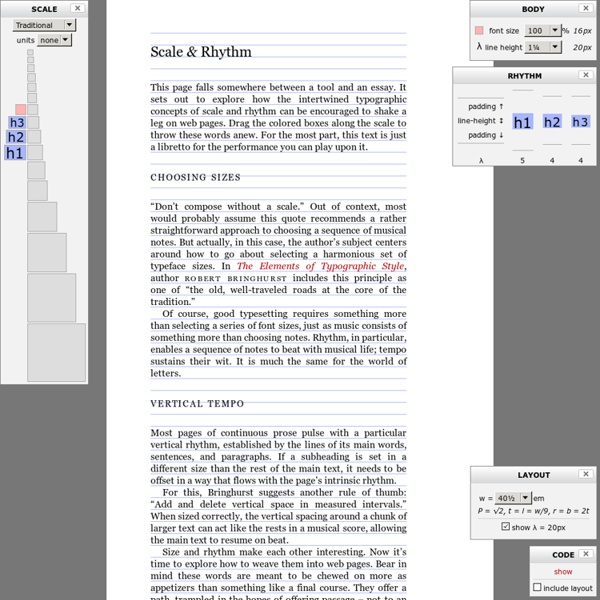CSS Typography: The Basics
Typography is an essential component of a website’s design. This is for good reason: good typography is not only imperative for aesthetic appeal, but also improves site usability when text legibility and readability concepts are applied. Typography is all about proportions and spacing.
Bonnes pratiques pour les déclarations @font-face
Petit rappel historique À l’origine, les déclarations CSS @font-face faisaient partie de la norme CSS 2.0 et étaient supportées aussi bien par Internet Explorer 6 que par Netscape 4. Nous étions alors à la fin des années 90 et la guerre entre ces deux navigateurs faisait rage. Malheureusement, les constructeurs ainsi que les fondeurs ne parvinrent pas à se mettre d’accord à l’époque sur un format de fonte et le haut débit n’étant pas encore généralisé, cette technologie ne fut que peu ou pas utilisée.
CSS Typography: Techniques and Best Practices
In the first part of this series, we discussed some fundamental concepts pertaining to CSS typography. Now we are going to cover some excellent techniques, tips, tricks and best practices for dealing with typography on websites. This is the second part of a three-part series of guides on CSS typography that will cover everything from basic syntax to best practices and tools related to CSS typography. Better Web Typography with @font-face For normal text blocks, using smart font stacks (as discussed in the first part) is a good idea, but for headings and short text blocks, more interesting fonts can be used with the help of @font-face.
Modularscale
CSS Typography: Examples and Tools
In the previous part of this series, we discussed some techniques and best practices for CSS typography. Let’s now delve into the subject further by looking into some case studies, tools, as well as a showcase of excellent CSS typography on the web. This is the third part of a three-part series of guides on CSS typography that will cover everything from basic syntax to best practices and tools related to CSS typography. Case Studies on CSS Typography Tutorials and theories can be great, but nothing says proof like a case study. Here are a handful of studies that can provide you with some real-world insights regarding typography on the web.
Layout Galaj
All layouts use valid markup and CSS, and have been tested successfully on Internet Explorer/win 5.0, 5.5, 6 and beta 2 preview of version 7; Opera 8.5, Firefox 1.5 and Safari 2. Each of the columns could be the longest, and for testing columns length I've used the script filler text on demand. Each layout could represent a site with five main sections: header, content, navigation, other stuff and footer. The basic markup, common to every layout, is the following: <div id="container"> <div id="header">Header</div> <div id="wrapper"> <div id="content">Content</div> </div> <div id="navigation">Navigation</div> <div id="extra">Extra stuff</div> <div id="footer">Footer</div> </div> It's almost minimal, apart from an extra wrapper around the content.
Using SVG in CSS with JavaScript detection
Warning This article was written over six months ago, and may contain outdated information. With the release of IE9 and Firefox 4 all major browsers are going to support using SVG in the img element or as a CSS background image, which is great news as SVG images are good for high definition, scalable websites. I’ve written a couple of posts recently about using SVG with the background-image property, and how to cope with browsers that don’t support it. The method I came up with works, but is far from elegant; for one thing, it doesn’t allow for transparency.
v0.3.8 documentation - lessphp
Documentation v0.4.0 lessphp is a compiler that generates CSS from a superset language which adds a collection of convenient features often seen in other languages. All CSS is compatible with LESS, so you can start using new features with your existing CSS.
LESS compiler in PHP - lessphp
New: lessphp 0.4.0, compiles Bootstrap 3, breaking changes, see Changelog (August 9th 2013) About lessphp is a compiler for LESS written in PHP. The entire compiler comes in a single includable class, but an additional command line interface to the compiler is included.
v0.3.8 documentation - lessphp
Documentation v0.4.0 lessphp is a compiler that generates CSS from a superset language which adds a collection of convenient features often seen in other languages. All CSS is compatible with LESS, so you can start using new features with your existing CSS.
Multi-column layout
Home / CSS3 Previews / Multi-column layout W3C offers a new way to arrange text “news-paper wise”, in columns. Multi-column layout is actually a module on its own. It allows a webdeveloper to let text be fitted into columns, in two ways: by defining a width for each column, or by defining a number of columns. The first would be done by column-width, the latter by column-count.



